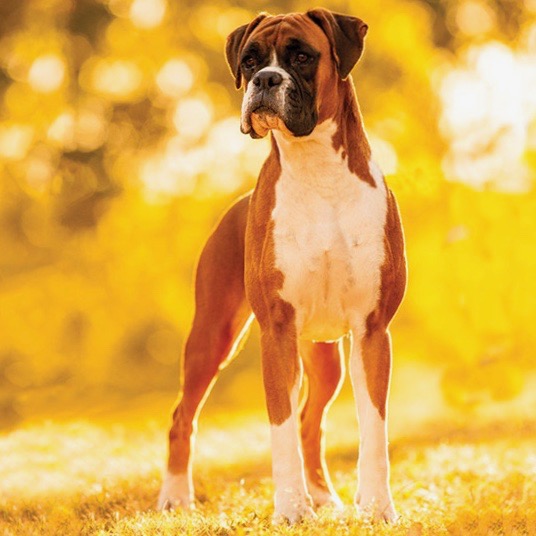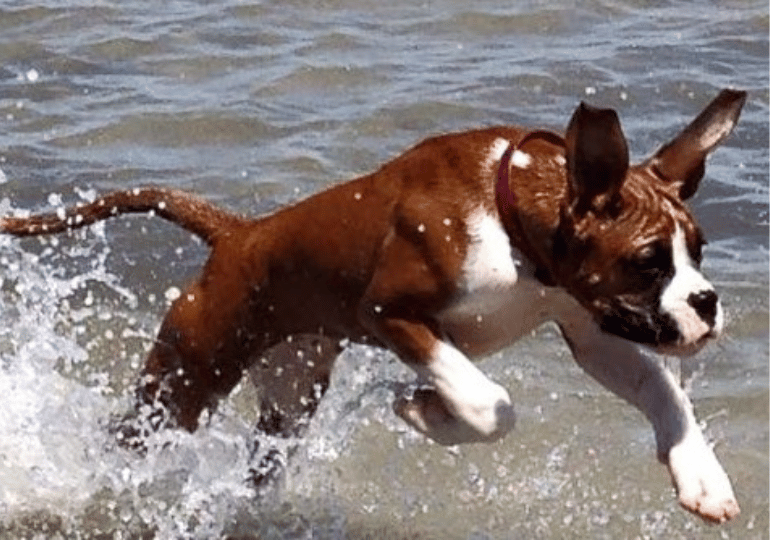Breeds
Boxer

GROUP 6 - UTILITY
Brief History
The Boxer was developed in Germany in the late 1800s from the now extinct Bullenbeisser, a dog of Masiff descent and Bulldogs brought in from England. The Boxer was used as a hunting dog, employed in the pursuit of bear, wild boar, and deer.
Average Life Span
When considering a dog, please realise that you are taking it on for its lifetime.
The average life span is 9 to 11 years.
Temperament
The mature Boxer should be fearless self-confident, calm and equable. Happy and friendly in play, yet fearless in a serious situation. Boxers are a bright, energetic and playful breed.
General Breed Description
The Boxer is a medium sized, smooth coated, sturdy dog of compact, square build and strong bone. His muscles are taut, strongly developed and moulded in appearance. His movement is lively, powerful with noble bearing. Boxer can be fawn, brindle or red. The brindle variety have black stripes on a golden-yellow or red-brown background. They often have a white underbelly and white on the front, face and feet. Some puppies are born all or mostly white.
Coat and Care Requirements
The Boxer has a short, shiny, smooth coat that lies tight to the body. Weekly brushing maintains a healthy coat. Feeding should be twice daily. Boxers are an athletic breed, and proper exercise and conditioning is important for their continued health and longevity.
Size
Height: Males 56 to 61cms (22 to 24ins), Females 53 to 58.5cms (21 to 23ins).
Weight: Males 30kgs, Females 28kgs.
Health
All breeds have individual health issues. When speaking to breeders it is recommended you enquire about the breed’s health and what health testing the breeder does. The Boxer is generally a healthy breed, however health conditions do occur occasionally. These may include, Heart, Hypothrroidism, and Degenerative Myelopathy (MD). Boxers are prone to develop some cancers.
Suitability
Boxers are best suited to the family environment but will adjust well to the sole owner. Young Boxers may be too demanding for elderly or frail owners. They are easy to train on account of their willingness to obey, his pluck and courage, natural keenness and scent capability. Training should be enjoyable and rewarding, not regimented and repetitive.
In Conclusion
Now you know a little more about this breed. If you have decided this is the dog for you and wish to investigate further, please contact the Breed Club or Dogs Victoria. They will be able to give you information about available puppies and also suggest dog events where you can see the breed and speak to breeders. In this way you will gain a better perspective of the breed and its needs. With any breed of dog, it is important to research and determine suitability for your lifestyle before committing to a puppy which will be a part of your family for many years to come.
Whilst many breeds are recommended for families, it is imperative that when children are with dogs they are supervised at all times. Basic obedience training is a vital part of dog ownership.
Dogs Victoria is about the responsible ownership of all dogs and in particular the preservation of pure breeds.
Link to Dogs Australia Breed Standard: https://dogsaustralia.org.au/breed/detail/175
Breeders



